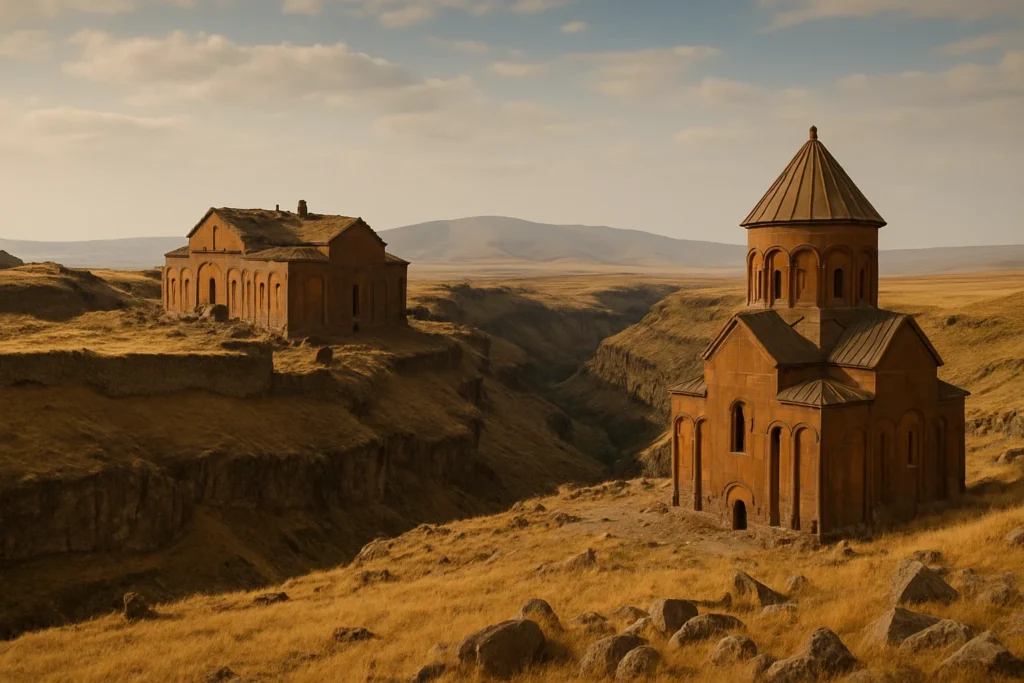Prologue: Where Time Stands Still and Empires Whisper
The wind on this remote, windswept plateau is more than just a current of air; it is the voice of history itself, a chorus of echoes that has resonated for millennia. Here, where the rugged borders of modern Türkiye meet the ancient lands of Armenia, the stones of Ani stand as silent witnesses to a breathtaking chronicle of human civilization. This is no ordinary archaeological site; it is an open-air museum where every weathered brick, every crumbling arch, and every half-erased fresco tells a vivid story of faith and conquest, of magnificent artistry and devastating destruction. It is a living testament to the eternal cycle of the rise and fall of empires, where the past is not a memory, but a presence.
As the first golden rays of a new day spill over the dramatic gorge of the Akhurian River, they illuminate the spectral remains of what was once known by many names: “The City of 1001 Churches,” a title that spoke of its spiritual and architectural grandeur; “The Cradle of Religions,” a testament to its spiritual diversity; and “The World’s Metropolis,” a reflection of its commercial and cultural dominance. The light slowly reveals the haunting, skeletal silhouette of the Cathedral’s broken arches, the mysterious and intricate carvings on the walls of the Church of St. Gregory, and the formidable, once-impenetrable walls that protected one of the medieval world’s greatest cities.
The 2016 designation of Ani as a UNESCO World Heritage Site marked not merely a recognition of its historical and cultural significance, but the beginning of a new, hopeful chapter. Yet, to truly grasp the profound importance of Ani, one must embark on a journey that stretches far beyond its medieval heyday. It is a journey through ten thousand years of history, tracing its path from prehistoric foundations to its golden age, and from centuries of neglect to its modern-day rebirth. This is the saga of Ani, a city that refused to be forgotten.
Book One: The Birth of a Civilization (3000 BCE – 884 CE)
Chapter 1: The Dawn of Ani – Prehistoric Foundations
The story of Ani begins not with kings and cathedrals, but with the subtle whispers of early human settlement. Long before the first Christian cross was carved into stone, the plateau overlooking the Akhurian River was a coveted location for ancient peoples. Evidence suggests a continuous habitation stretching back to the Chalcolithic period (5000-3000 BCE). Archaeological excavations, painstaking and revealing, have brought to light the foundational layers of this history. Researchers have uncovered:
- Stone tools and pottery fragments that speak of the daily lives of these early inhabitants, their methods of hunting, and their artistic expressions.
- Burial mounds containing precious obsidian weapons and intricate copper ornaments, artifacts that offer a glimpse into their social structures and belief systems.
- Early agricultural terraces and irrigation channels, a marvel of ancient engineering, which show how these prehistoric peoples managed to cultivate the rocky, unforgiving landscape.
The strategic advantages of this location were instinctively recognized by these early civilizations. The natural defenses provided by the steep cliffs on three sides made it an ideal location for a fortress, while its position allowed for control of vital trade routes that linked the fertile lands of Anatolia with the vast resources of the Caucasus. Crucially, the abundant water sources from the river and a network of underground springs ensured the sustainability of their communities, laying the groundwork for the great city to come.
Chapter 2: The Urartian Connection and the Crossroads of Empires (860 BCE – 884 CE)
As the region’s first major empire, the Urartians, rose to power, they left an indelible mark on Ani’s early history. Cuneiform inscriptions found at the nearby Urartian fortress of Çavuştepe mention a settlement called “Ani” as early as the 8th century BCE, confirming its existence as a strategic outpost. The Urartians, renowned for their impressive engineering and military architecture, bequeathed a legacy that would be foundational to Ani’s future greatness. Archaeological findings point to:
- Massive cyclopean walls constructed from large, irregularly shaped stones, a style reminiscent of the fortifications at the Urartian capital, Tushpa.
- Advanced irrigation systems and aqueducts that harnessed the power of the Akhurian River, far preceding similar Roman innovations.
- Religious artifacts and engravings dedicated to the Urartian god Haldi, revealing the cultural and spiritual influences that permeated the region.
The passing of the Urartian empire led to a new chapter for Ani, as it fell under the sway of a succession of new and powerful civilizations. For centuries, it transitioned from a Persian satrapy to a Macedonian outpost, then a Roman and later a Byzantine military fortress. Each empire left its own mark, with evidence of Zoroastrian fire temples under Sassanian rule and the gradual establishment of early Christian communities after Armenia’s conversion in 301 CE. While these periods were crucial, Ani remained a provincial town, overshadowed by nearby capitals like Dvin and Kars. The stage was being set for a new power to rise, and with it, a new age for Ani.
Book Two: The Golden Millennium (884-1239 CE)
Chapter 3: The Bagratid Renaissance and the City of a Thousand and One Churches
The true birth of Ani as a global metropolis occurred in 884 CE, when King Ashot I of the Bagratid dynasty chose it as his capital. This decision sparked a cultural, political, and economic explosion that would last for nearly two centuries, transforming Ani from a regional fortress into a global superpower. Under the visionary rule of the Bagratids, the city experienced a renaissance in every sense of the word. Ani rapidly grew into:
- A center of intellectual life, home to renowned schools of philosophy, medicine, and theology that attracted scholars from across the region.
- An architectural marvel where groundbreaking designs pushed the boundaries of what was possible in stonework and engineering.
- A bustling commercial hub, where the pulse of global trade could be felt in every bustling alley and crowded market.
The city’s population swelled to an astonishing 200,000 people, making it one of the largest and most densely populated cities of its time. The city was a microcosm of the medieval world, with distinct neighborhoods that catered to its diverse populace: Armenian nobles lived in magnificent stone mansions, Persian merchants traded in the vibrant bazaar district, Byzantine diplomats mingled near the royal palace, and Georgian artisans worked their craft in the workshops quarter. The nickname, “City of a Thousand and One Churches,” was not a poetic exaggeration but a literal reflection of the city’s profound spiritual and architectural vibrancy, with its skyline bristling with the domes and spires of countless Christian churches, monasteries, and chapels.
Chapter 4: Masterpieces in Stone – Ani’s Architectural Revolution
The true glory of Bagratid Ani lay in its breathtaking architectural innovations, a brilliant synthesis of different cultural influences. The city’s architects masterfully blended:
- Classical Armenian traditions of elegant symmetry and intricate ornamentation.
- Byzantine engineering, which allowed for the construction of massive, awe-inspiring domes.
- Persian decorative arts, seen in the geometric patterns and flowing script adorning various structures.
- Emerging Islamic influences that would become more prominent in later centuries.
Three structures stand out as the crowning jewels of this golden age:
1. The Cathedral of Ani (989-1001): Designed by the legendary architect Trdat, who was later summoned to Constantinople to repair the dome of the Hagia Sophia, this cathedral was a marvel of its time. Its revolutionary design featured a massive 34-meter dome supported by four imposing pillars, and, most importantly, its use of elegant pointed arches is now widely recognized as a precursor to the Gothic architectural style that would not appear in Western Europe for another two centuries.
2. The Church of St. Gregory of Tigran Honents (1215): A private chapel commissioned by a wealthy merchant, this church is celebrated for housing some of the best-preserved medieval frescoes in the world. Its walls are a vibrant canvas depicting detailed scenes from the life of Christ and St. Gregory the Illuminator, offering a priceless glimpse into the religious and artistic sensibilities of the era. The chapel also features exquisite khachkar (cross-stone) carvings and a unique two-story design.
3. The City Walls (964-977): King Smbat II’s monumental city walls were a defensive masterpiece, a testament to the city’s power and its determination to protect itself. The formidable fortifications included towering, 8-meter-high double walls, reinforced by over 40 semicircular towers, and punctuated by three massive, decorated gates (the Lion Gate, Kars Gate, and Dvin Gate), which served as the grand entrances to the metropolis.
Chapter 5: The Silk Road Metropolis: The Flow of Commerce and Culture
Ani’s unrivaled position on the Northern Silk Road was the engine of its prosperity. It served as the central marketplace where East met West, a bustling hub where ideas, goods, and people converged. Caravans journeyed for months to reach Ani, bringing with them a world of exotic treasures:
- From China: Precious silk fabrics, delicate porcelain, and the secrets of papermaking.
- From India: Rare spices, glittering gems, and vibrant dyes.
- From Persia: Finely woven carpets, intricate metalwork, and lyrical poetry.
- From Byzantium: Exquisite glassware, religious artifacts, and finely crafted jewelry.
- From the Steppes: Luxurious furs, barrels of honey, and gleaming amber.
The city’s economic dominance was so great that it minted its own coins, bearing inscriptions in Armenian, Arabic, Greek, and Syriac—a powerful symbol of its multicultural character and its role as a nexus of global trade. The city’s vibrant bazaar was a sensory overload of sights, sounds, and smells, a place where fortunes were made and new ideas were born.
Book Three: The Age of Conquests (1045-1579)
Chapter 6: The Turbulent Transition: From Byzantine to Seljuk Rule
Ani’s golden age of independence came to an end in 1045, when Byzantine Emperor Constantine IX annexed the city. This marked the beginning of a turbulent period, characterized by the deportation of Armenian nobles and the gradual neglect of the city’s infrastructure. However, an even greater shift occurred in 1064, when Alp Arslan of the Seljuk Turks conquered the city. This event initiated Ani’s Islamic era, a time of significant cultural and religious transformation. The Seljuks:
- Converted the majestic Cathedral into the Fethiye Mosque, a symbol of their new rule.
- Constructed the elegant Manuchihr Mosque, which stands as one of the oldest Turkish mosques in Anatolia, a testament to the seamless blend of cultures.
- Introduced new architectural elements, such as Persian-style minarets, which rose gracefully alongside the city’s existing Christian churches.
The city continued to change hands, and under the rule of Queen Tamar of Georgia in 1199, Ani experienced a brief but significant cultural revival, with the restoration of damaged churches and the flourishing of manuscript illumination. This period, however, was a final, fleeting moment of peace before a new and more destructive force would sweep across the land.
Book Four: The Long Decline (1239-Present)
Chapter 7: The Mongol Cataclysm and Centuries of Silence
The year 1239 marked a turning point from which Ani would never fully recover. The Mongol invasion under Chormaqan brought unimaginable devastation. The city’s population was massacred, its intricate irrigation systems were destroyed, and the intricate web of trade that had sustained its prosperity collapsed overnight. The city that had once been a symbol of life and commerce was now a desolate ruin.
Ani gradually faded into obscurity, becoming little more than a ghostly memory. For centuries, it served as a brutal battleground for Ottoman-Persian wars, its stones battered by cannons and its walls slowly dismantled. It was treated as a convenient quarry for nearby villages, its precious architectural elements repurposed for new homes and fortifications. Ani became a forgotten ruin, a silent city visited only by shepherds and the whispers of the wind.
Chapter 8: The Rediscovery and the Call for Preservation
It was not until the 19th century that European travelers and scholars, captivated by its forgotten grandeur, brought Ani back to the world’s attention. Explorers like H.F.B. Lynch published detailed sketches and vivid descriptions, sparking international interest. The first archaeological surveys were conducted, revealing the immense scope and historical value of the site. As the scale of Ani’s historical significance became clear, a growing chorus of voices called for its preservation before it was lost to time forever.
Book Five: Ani Reborn (20th Century-Present)
Chapter 9: The Modern Rescue Effort: A New Hope
In recent decades, a monumental effort has been underway to save Ani from its long decline. A new era of preservation and research has been marked by:
- The structural stabilization of its most endangered monuments, including the Cathedral and the Church of St. Gregory.
- Digital documentation projects that have created detailed 3D models and virtual tours of the ruins, preserving them for future generations.
- Careful archaeological excavations that are still unearthing new artifacts and expanding our understanding of the city’s vast history.
Chapter 10: UNESCO Recognition and Beyond: A New Chapter
The 2016 UNESCO designation was the culmination of these efforts, and it has opened a new chapter for Ani. The recognition has already spurred:
- A significant increase in eco-tourism, with a focus on sustainable management to protect the fragile site.
- An increase in international scholarly collaboration, with researchers from around the globe working together to piece together Ani’s history.
- Hopes for more cross-border cultural initiatives and dialogue, turning a place of historical division into a symbol of shared heritage and peace.
Epilogue: The Stones Still Speak
As the sun sets over the ruins of Ani, casting long, solemn shadows across the Cathedral’s broken arches and the Church of St. Gregory’s weathered frescoes, one can almost hear the echoes of a lost world. The prayers of medieval monks, the clamor of Silk Road merchants, the marching boots of conquering armies, and the chisels of master architects all seem to linger in the air.
Ani stands today not merely as a monument to the past, but as a powerful mirror to our shared human experience. It is a reminder that civilizations rise and fall, but great art, visionary architecture, and the spirit of human ingenuity endure. The story of Ani continues to unfold with every new excavation and every new visitor. It invites us all to listen to the whispers of history carried on the winds of the Anatolian plateau and to remember that the stories of our past are essential to understanding our future.



